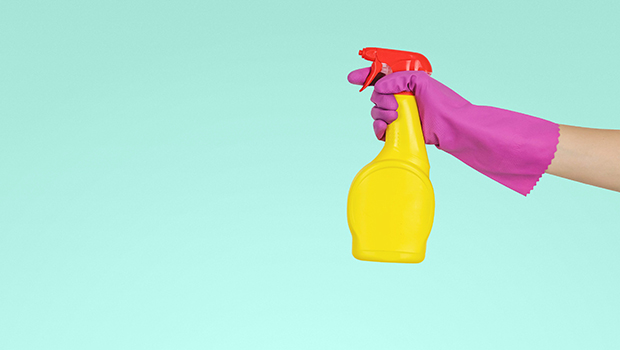You don’t need harsh (and expensive) chemicals to clean your kitchen. Regular pantry staples such as vinegar, lemon and bicarbonate of soda can do the trick just as well. Read on for some handy advice on how to use these ingredients as cleaning agents.
How to use lemon to clean your kitchen
Lemon is for more than just adding to your summer G&T. According to How to Clean Just About Anything by Jeff Bredenberg, you can dip a slice of lemon into salt and then rub it along the edge of a carbon steel knife blade to get rid of stains. You can also use lemon dipped in salt to shine chrome surfaces – simply rinse well with water afterwards and use a clean cloth to buff the surface. If you have a plastic laminated surface, you can also use lemon – combine the juice with cream of tartar to remove stubborn stains.
You can’t go wrong armed with white vinegar. If you’re short on lemons, you can use a mixture of white vinegar and salt to shine chrome surfaces – simply follow the same method as for lemons – or to remove stains from a carbon steel knife blade. Vinegar and cream of tartar also form the perfect paste to get rid of stickiness on chrome stovetops.
Instead of using a shopbought decalcifier, you can also use white vinegar to clean an electric drip coffeemaker. Half-fill the reservoir with cold water, then fill it up with white vinegar. Place a clean paper filter in the basket and then run the coffee maker through one cycle (without coffee, of course). Run it through two more cycles with only water to properly rinse it.
You can also add two tablespoons of white vinegar to the water when washing dishes (along with regular dishwashing liquid). “This boosts the power of inexpensive dishwashing liquid and makes even the best dish detergent work better,” says How to Clean Just About Anything. If you notice lime buildup on glasses that are regularly washed in a dishwasher, pop them into a large plastic bowl filled with white vinegar for 15 minutes. Be sure to rinse well with running water afterwards and leave to airdry for glasses that look as good as new.
Finally, instead of using an all-purpose cleaner, spray your refrigerator shelves with a squirt of white vinegar and wipe it with a clean paper towel for a sanitary, easy clean.
Bicarbonate of soda is another ingredient you don’t ever want to be caught without. To remove stubborn food stains from a cooler box or plastic container, rub a paste made from bicarbonate of soda mixed with water all over the stain, rub then rinse. You can also sprinkle bicarb over a plastic laminated kitchen countertop, then rub it with a soft, damp cloth, before rinsing and drying.
To get rid of smells in a microwave, wipe it with one cup of water mixed with one tablespoon of bicarbonate of soda. (Lemon juice mixed with water will also work well here.) Keep an open box of bicarbonate of soda in your refrigerator as well to absorb unwanted smells.
Finally, you can also use bicarbonate of soda to get rid of stains on porcelain, including a porcelain sink or tea set. To remove coffee or tea stains from inside porcelain cups or a teapot, or to clean a lightly stained sink, gently rub with a paste made from bicarbonate of soda mixed with water.
For more handy cleaning tips, put on your gloves, grab your spray bottle and join the fearless teams who are cleaning up the streets of Britain in Grime and Punishment, weekdays at 18:40 on CBS Reality, DStv channel 132.

